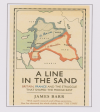The Line in the Sand.
The end of the Ottoman Empire came after WW 1. They surrendered to the Allies (Britain and France) in 1918. Despite fighting alongside the Allies, the Arab patriots felt betrayed as they did not receive what they expected. The governments of the European Entente (an informal alliance) had concluded a secret treaty before the armistice, the Sykes-Picot Agreement, partitioning the Middle East amongst themselves.
After the Ottomans withdrew, Arab leaders proclaimed an independent state in Damascus but were quickly overcome by British and French forces. Subsequently, Britain and France established control and redefined the Middle Eastern boundaries.
A `line in the sand` was drawn to indicate the French and British territories. Syria became a French protectorate, and the coastal areas were split off to become Lebanon, another French protectorate. Iraq, Jordan and Palestine became British mandated territories on behalf of the League of Nations.
Arab Relations.
The agreement is seen by many as a turning point in Western and Arab relations. It reneged upon Britian`s promises regarding a national Arab homeland in the region of Syria in exchange for supporting the British against the Ottoman Empire.
Israelis Relations.
The British also had endorsed the Balfour declaration promising the international Zionist movement their support in re-creating the historic homeland in Palestine. This is in line with God`s plan for His people, Israel returning to their homeland.
Discovery of oil.
The discovery of oil in the Middle East sparked the region's modernization. Roads, water, sewage, buildings, and banking infrastructure. All helped to bring the Middle East into the 20th century.
However, with the growth and prosperity, there were tensions. The colonial powers were seen as overlords and independence was keenly sought. The Arabs desired to manage and receive the profits from their own oil, stirring their desire to rise as a global power enabling them to rule the world.

The end of the Ottoman Empire came after WW 1. They surrendered to the Allies (Britain and France) in 1918. Despite fighting alongside the Allies, the Arab patriots felt betrayed as they did not receive what they expected. The governments of the European Entente (an informal alliance) had concluded a secret treaty before the armistice, the Sykes-Picot Agreement, partitioning the Middle East amongst themselves.
After the Ottomans withdrew, Arab leaders proclaimed an independent state in Damascus but were quickly overcome by British and French forces. Subsequently, Britain and France established control and redefined the Middle Eastern boundaries.
A `line in the sand` was drawn to indicate the French and British territories. Syria became a French protectorate, and the coastal areas were split off to become Lebanon, another French protectorate. Iraq, Jordan and Palestine became British mandated territories on behalf of the League of Nations.
Arab Relations.
The agreement is seen by many as a turning point in Western and Arab relations. It reneged upon Britian`s promises regarding a national Arab homeland in the region of Syria in exchange for supporting the British against the Ottoman Empire.
Israelis Relations.
The British also had endorsed the Balfour declaration promising the international Zionist movement their support in re-creating the historic homeland in Palestine. This is in line with God`s plan for His people, Israel returning to their homeland.
Discovery of oil.
The discovery of oil in the Middle East sparked the region's modernization. Roads, water, sewage, buildings, and banking infrastructure. All helped to bring the Middle East into the 20th century.
However, with the growth and prosperity, there were tensions. The colonial powers were seen as overlords and independence was keenly sought. The Arabs desired to manage and receive the profits from their own oil, stirring their desire to rise as a global power enabling them to rule the world.


